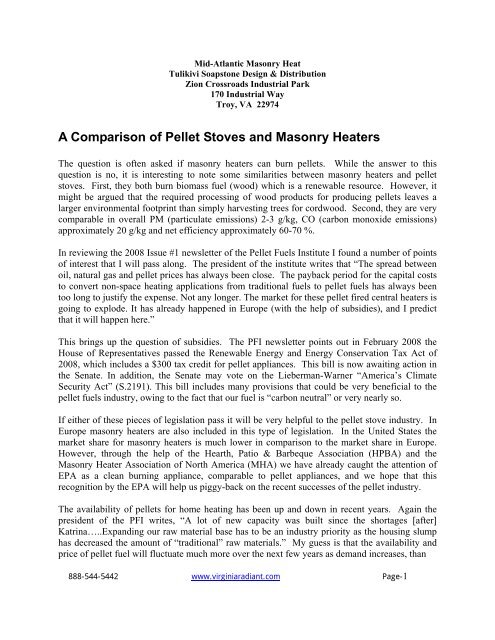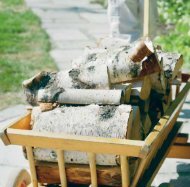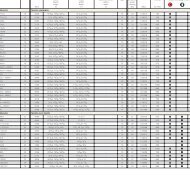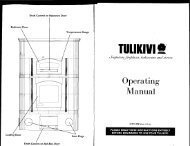A Comparison of Pellet Stoves and Masonry Heaters - Mid-Atlantic ...
A Comparison of Pellet Stoves and Masonry Heaters - Mid-Atlantic ...
A Comparison of Pellet Stoves and Masonry Heaters - Mid-Atlantic ...
Create successful ePaper yourself
Turn your PDF publications into a flip-book with our unique Google optimized e-Paper software.
<strong>Mid</strong>-<strong>Atlantic</strong> <strong>Masonry</strong> Heat<br />
Tulikivi Soapstone Design & Distribution<br />
Zion Crossroads Industrial Park<br />
170 Industrial Way<br />
Troy, VA 22974<br />
A <strong>Comparison</strong> <strong>of</strong> <strong>Pellet</strong> <strong>Stoves</strong> <strong>and</strong> <strong>Masonry</strong> <strong>Heaters</strong><br />
The question is <strong>of</strong>ten asked if masonry heaters can burn pellets. While the answer to this<br />
question is no, it is interesting to note some similarities between masonry heaters <strong>and</strong> pellet<br />
stoves. First, they both burn biomass fuel (wood) which is a renewable resource. However, it<br />
might be argued that the required processing <strong>of</strong> wood products for producing pellets leaves a<br />
larger environmental footprint than simply harvesting trees for cordwood. Second, they are very<br />
comparable in overall PM (particulate emissions) 2-3 g/kg, CO (carbon monoxide emissions)<br />
approximately 20 g/kg <strong>and</strong> net efficiency approximately 60-70 %.<br />
In reviewing the 2008 Issue #1 newsletter <strong>of</strong> the <strong>Pellet</strong> Fuels Institute I found a number <strong>of</strong> points<br />
<strong>of</strong> interest that I will pass along. The president <strong>of</strong> the institute writes that “The spread between<br />
oil, natural gas <strong>and</strong> pellet prices has always been close. The payback period for the capital costs<br />
to convert non-space heating applications from traditional fuels to pellet fuels has always been<br />
too long to justify the expense. Not any longer. The market for these pellet fired central heaters is<br />
going to explode. It has already happened in Europe (with the help <strong>of</strong> subsidies), <strong>and</strong> I predict<br />
that it will happen here.”<br />
This brings up the question <strong>of</strong> subsidies. The PFI newsletter points out in February 2008 the<br />
House <strong>of</strong> Representatives passed the Renewable Energy <strong>and</strong> Energy Conservation Tax Act <strong>of</strong><br />
2008, which includes a $300 tax credit for pellet appliances. This bill is now awaiting action in<br />
the Senate. In addition, the Senate may vote on the Lieberman-Warner “America’s Climate<br />
Security Act” (S.2191). This bill includes many provisions that could be very beneficial to the<br />
pellet fuels industry, owing to the fact that our fuel is “carbon neutral” or very nearly so.<br />
If either <strong>of</strong> these pieces <strong>of</strong> legislation pass it will be very helpful to the pellet stove industry. In<br />
Europe masonry heaters are also included in this type <strong>of</strong> legislation. In the United States the<br />
market share for masonry heaters is much lower in comparison to the market share in Europe.<br />
However, through the help <strong>of</strong> the Hearth, Patio & Barbeque Association (HPBA) <strong>and</strong> the<br />
<strong>Masonry</strong> Heater Association <strong>of</strong> North America (MHA) we have already caught the attention <strong>of</strong><br />
EPA as a clean burning appliance, comparable to pellet appliances, <strong>and</strong> we hope that this<br />
recognition by the EPA will help us piggy-back on the recent successes <strong>of</strong> the pellet industry.<br />
The availability <strong>of</strong> pellets for home heating has been up <strong>and</strong> down in recent years. Again the<br />
president <strong>of</strong> the PFI writes, “A lot <strong>of</strong> new capacity was built since the shortages [after]<br />
Katrina…..Exp<strong>and</strong>ing our raw material base has to be an industry priority as the housing slump<br />
has decreased the amount <strong>of</strong> “traditional” raw materials.” My guess is that the availability <strong>and</strong><br />
price <strong>of</strong> pellet fuel will fluctuate much more over the next few years as dem<strong>and</strong> increases, than<br />
888-544-5442 www.virginiaradiant.com Page-1
will the availability <strong>and</strong> price <strong>of</strong> cordwood for a masonry heater. Also just like pellet stoves you<br />
can burn recycled wood scraps from construction, cabinet shops <strong>and</strong> shipping pallets. Often<br />
these materials are free for the asking.<br />
While you get to use biomass fuel <strong>and</strong> have relatively comparable emissions <strong>and</strong> efficiencies<br />
with masonry heaters <strong>and</strong> pellet appliances, there are some major differences. The first, in favor<br />
<strong>of</strong> pellet stoves, is price. <strong>Masonry</strong> heaters are much more expensive. However, the higher initial<br />
cost <strong>of</strong> a masonry heating system can be paid back in a number <strong>of</strong> ways. A masonry heater, like<br />
a masonry fireplace, adds fire viewing enjoyment <strong>and</strong> value to your home. Installed cost a<br />
masonry heater can actually be very comparable to a conventional masonry fireplace, but the<br />
value for the money is considerably higher. The investment in a masonry heater is working for<br />
you every day <strong>of</strong> the heating season as an active thermal mass storage system gently heating your<br />
home with comfortable radiant heat.<br />
Now for some advantages <strong>of</strong> heating with a masonry heater. First, one <strong>of</strong> the biggest problems<br />
with using a hot air convection appliance like a pellet stove, in the relatively mild climate <strong>of</strong> the<br />
<strong>Mid</strong>-<strong>Atlantic</strong> <strong>and</strong> South Eastern region <strong>of</strong> the country, is that most <strong>of</strong> the heating season is<br />
actually spring <strong>and</strong> fall weather. Real winter weather is only a few weeks long…..not months in<br />
duration as compared to the Northern regions <strong>of</strong> the country. This is an important consideration.<br />
Much <strong>of</strong> the time, the average energy dem<strong>and</strong> <strong>of</strong> your house will be quite low. The BTU output<br />
from a pellet stove will most likely be greater than comfort allows during the spring <strong>and</strong> fall<br />
portion <strong>of</strong> the heating season <strong>and</strong> will work satisfactorily only when it is fairly cold outside. In<br />
other words it will produce too much heat during the lengthy fall <strong>and</strong> spring heating seasons in<br />
the southern regions <strong>of</strong> the country.<br />
Another positive consideration in favor <strong>of</strong> a masonry heater is its ability to provide even heat<br />
over a much larger area within your home. A masonry heater produces radiant heat which<br />
warms wall, ceilings, floors <strong>and</strong> objects in the room, not the air directly. The air in the room is<br />
warmed in turn to the same temperature as the surfaces <strong>and</strong> objects in the room. The secret <strong>of</strong><br />
natural convection <strong>of</strong> air to adjoining rooms lies in the fact that the surface temperatures in the<br />
adjoining rooms (being in the shade) are slightly cooler than in the room directly heated by the<br />
masonry heater (being in the sun). The laws <strong>of</strong> thermal dynamics dictate that heat flows from<br />
warm surfaces to cool surfaces. This occurs through convection <strong>of</strong> air between rooms. As long<br />
as there is an opening between rooms the air temperate will equalize naturally. The natural<br />
convection process will continue until the wall surfaces in both rooms are equal. Convection<br />
between rooms will not stop until the masonry heater stops radiating to the surfaces <strong>of</strong> the room<br />
in which it is located (normally between 12 to 24 hours). When you walk from one room to the<br />
next it will be similar to walking from the direct rays <strong>of</strong> the sun in to the shade. When you walk<br />
into an adjoining room you will lose the direct warmth <strong>of</strong> the masonry heater’s “sunshine” but<br />
the air temperature will change very little if at all.<br />
With a hot air convection appliance like a pellet stove most <strong>of</strong> the convection related to the<br />
appliance occurs within the room in which it is located <strong>and</strong> not between adjacent rooms. This is<br />
888-544-5442 www.virginiaradiant.com Page-2
why you are <strong>of</strong>ten to hot in the room with the appliance <strong>and</strong> too cool in the adjoining rooms.<br />
With pellet stove or forced air systems that generate hot air, the air rises to the ceiling, comes in<br />
contact with the coolest outside wall in the room, settles to the floor, sweeps across the floor<br />
creating a draft on its way back to the pellet stove or the cold air return <strong>of</strong> the forced air system.<br />
The colder it is outside, the greater the need for more hot air, the greater the speed <strong>of</strong> convection<br />
(air movement) in the room, the greater the “wind chill” in the room, the less comfortable you<br />
are in the room. Often with a convection type heat system, the only solution for comfort is to<br />
wrap a blanket around you as you read a book or watch television. On the other h<strong>and</strong>, with a<br />
radiant system you just sit in the sunshine.<br />
As a convection heat appliance, the pellet stove blows hot air into the room, circulates dust, dries<br />
out the air <strong>and</strong> promotes draft conditions in your living space. The radiant heat from a masonry<br />
heater does not produce these negative effects. The quality <strong>and</strong> comfort <strong>of</strong> the heat from a pellet<br />
stove can not compete with the radiant warmth <strong>of</strong> a masonry heater, which comfortably heats<br />
your home from the earliest needs in the fall heating season to the last needs in the spring heating<br />
season.<br />
<strong>Pellet</strong> stoves require electricity to operate, masonry heaters do not. In an emergency, you will<br />
still have heat for your home when you heat with a masonry heater.<br />
The circulating fan <strong>of</strong> a pellet stove runs constantly during operation producing background<br />
noise in the room in which it is located. <strong>Masonry</strong> heaters produce the sounds <strong>of</strong> a crackling fire<br />
as they are being charged (usually for one to three hours) <strong>and</strong> are silent during the rest <strong>of</strong> the<br />
heating cycle.<br />
<strong>Pellet</strong> stove require frequent cleaning maintenance <strong>and</strong> in order to operate efficiently. <strong>Masonry</strong><br />
heaters produce very little ash which is easily removed <strong>and</strong> recycled to your lawn or garden.<br />
Due to the high combustion temperatures (1100 to 1800 degrees Fahrenheit) only the mineral<br />
content <strong>of</strong> the wood is left after a fire.<br />
<strong>Pellet</strong> stoves are at best utilitarian to look at. <strong>Masonry</strong> heater can be designed to fit into the<br />
architecture <strong>of</strong> the home <strong>and</strong> provide a wonderful focal point for the room in which it is located.<br />
They can add substantial value to your home, particularly when you look at the overall cost for<br />
heating the home, not to mention the dramatically improved comfort <strong>of</strong> the home during the<br />
heating season.<br />
888-544-5442 www.virginiaradiant.com Page-3





